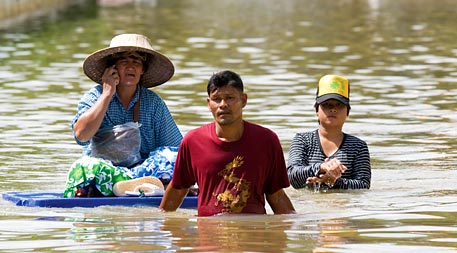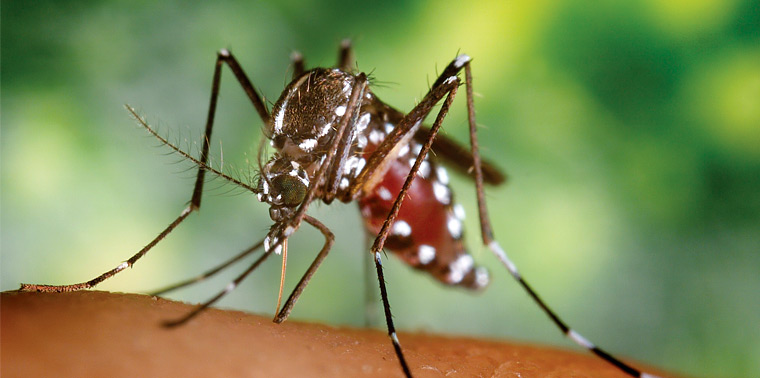December 16, 2012 — When a freakish heat wave struck France and central Europe in 2003, more than 50,000 people died in 11 days.
Were they casualties of climate change?
“That was a public health disaster,” says Jonathan Patz, professor of environmental studies and population health sciences at the University of Wisconsin–Madison. “Attribution to climate change is a difficult thing.”
And not simply because it is impossible to pin singular events on a changing climate. Other factors—changing land use, trade and travel, pest control, and air and water pollution—obscure and overwhelm the effects of climate change.
Until recently, the mosquito-borne West Nile virus was confined to tropical and subtropical Africa.
“It is really quite impossible to disentangle the many confounding factors,” says Patz.
That, however, has not kept experts from warning that climate change has the potential to affect health in many ways. In considering just four diseases – cardiovascular disease, malnutrition, diarrhea and malaria – and death from flooding, the World Health Organization estimated 166,000 deaths could be attributed to the effects of climate change in 2000.
“Unlike a single agent of disease, or single toxic element or pollutant, climate change is something that cuts across many exposure pathways to affect our health,” says Patz. “These range from the direct effects of heat waves and even stagnant air masses and air pollution, to more of these ecologically mediated effects on infectious diseases.”
Myriad Consequences
Public health and disease specialists have warned for more than a decade that a warming planet could threaten health, especially of the world’s poor.
A 2009 report of the U.S. Interagency Working Group on Climate Change and Health noted that “climate change is currently affecting public health through myriad environmental consequences, such as sea-level rise, changes in precipitation resulting in flooding and drought, heat waves, changes in intensity of hurricanes and storms, and degraded air quality, that are anticipated to continue into the foreseeable future.”
Some impacts are intuitive. If warming leads to more and bigger tropical storms – a hypothesis still in doubt – then catastrophes like Hurricane Katrina will become more common. If climate change amplifies the world’s water cycle, as is generally accepted, increased rainfall and floods are likely. Worldwide, floods are the most common weather disaster. According to the United Nations, the number of people affected by floods and storms worldwide has risen steadily since 1975. Besides killing people outright, floods also pollute water supplies and lead to widespread waterborne disease such as cholera, cryptosporidiosis and giardiasis.
Also unsurprising are predictions of more killer heat waves. Writing in Nature, a team from Britain estimated “it is very likely” that human-caused global warming at least doubled the chances of the 2003 European heat wave. In the U.S., according to the Intergovernmental Panel on Climate Change, Chicago is expected to brave heat waves with 25 percent greater frequency by the end of the century. Los Angeles can expect a four- to eightfold increase in heat wave days. According to the U.S. Environmental Protection Agency, heat is already the leading cause of weather-related death. The heat wave that hit Chicago in 1995 is estimated to have killed more than 700 people.
But of all health hazards posed by climate change, one of the most intriguing is the expansion of infectious diseases. In a 2000 Scientific American article, Paul Epstein, associate director of the Center for Health and the Global Environment at Harvard Medical School, predicted the spread of tropical diseases, with maps of lurid colors forecasting an increase in malaria risk across Europe and the eastern United States. In 2007 the IPCC stated, “climate change currently contributes to the global burden of disease and premature deaths.” It makes sense: The world gets warmer; tropical and subtropical diseases move to higher latitudes.
Indeed, though changes in the distribution of infectious disease can’t be definitively attributed to climate change, they definitely seem to be happening. Ticks carrying viruses associated with encephalitis are creeping northward in Europe. A 2004 outbreak of gastroenteritis from the consumption of raw Alaskan oysters extended the known range of Vibrio parahaemolyticus northward by 600 miles.
Climate change is predicted to expand the range of the black-legged tick, vector for Lyme disease. Nicholas Ogden, a researcher with the Centre for Foodborne, Environmental and Zoonotic Infectious Diseases in Quebec, predicts the tick could spread to much of southern Ontario and Quebec by 2020.
Until recently, the mosquito-borne West Nile virus was confined to tropical and subtropical Africa. Since it reached the United States in 1999, it has spread across the continent as far north as Alaska. Research has pinned increasing infections on warmer temperatures, elevated humidity and heavy precipitation.
Of all mosquito-borne diseases, malaria is the deadliest, killing close to 1 million each year. Many scientists predict malaria’s range will spread as the climate becomes more suitable for dozens of host species of mosquito. Taking into account both spreading malaria and increasing human population, the IPCC predicts an additional 220 million to 400 million people will be exposed to malaria during the next century.
Cautionary View
Despite these warnings, writes Sarah Randolph, professor of parasite ecology at Oxford University, “There is no single infectious disease whose increased incidence over recent decades can be reliably attributed to climate change.” Randolph calls the number of deaths due to climate change “inestimable.”
Scientists, she argues, have been beguiled by doom-filled scenarios while discounting situations where diseases are likely to decrease. They have assumed that climate will strengthen virulence rather than disrupt “the delicate balance between pathogen, vector and host.”
“She forced me to take a more critical evaluation instead of just nodding my head at what seemed to make sense,” says Kevin Lafferty, research scientist at the Western Ecological Research Center, UC Santa Barbara. Lafferty wrote a cautionary review on climate change and infectious diseases that appeared in Ecology in 2009.
“In going through the literature, I became more and more convinced that the story was much more complex,” he says. “At this point, if you look at the weight of the evidence for malaria and a lot of other infectious diseases, and at sort of the general theory about how organisms respond to the climate, the expectation is that we should see shifts, not net increases.”
Recent models, Lafferty says, show some diseases spreading in some areas, contracting in others. As the Climate Change Working Group summarized in 2007, “models project that, particularly in Africa, climate change will be associated with geographical expansions of the areas suitable for stable Plasmodium falciparum malaria in some regions and with contractions in other regions. … Some central Asian areas are projected to be at increased risk of malaria, and areas in Central America and around the Amazon are projected to experience reductions in transmission due to decreases in rainfall.”

©Thor Jorgen Udvang/Shutterstock.com
A recent survey of local public health directors showed most believed climate change poses a formidable challenge to public health. Yet only a small minority had made adaptation a top priority because they lacked knowledge, expertise or resources.
“One of the most important things to do is to gather information,” says David Neitzel, a vector-borne disease specialist for the Minnesota Department of Health. “It’s important to have strong disease monitoring in place. We want to be able to see when things are changing.”
Scientists are trying to develop more sophisticated models to predict changing threats. As the World Health Organization has pointed out, the biggest problem, especially in poor societies, is not predicting a threat, but responding once it arrives. For that reason, says Neitzel, modern infrastructure, good health care and competent emergency response are the best preparation, “so that if some sort of disaster happens we’re able to adapt, so that people aren’t living underneath tarps.”
This article originally appeared in the Spring 2011 issue of Momentum magazine, Ensia’s predecessor, as “Sick of It?”
Ensia shares solutions-focused stories free of charge through our online magazine and partner media. That means audiences around the world have ready access to stories that can — and do — help them shape a better future. If you value our work, please show your support today.
Yes, I'll support Ensia!
